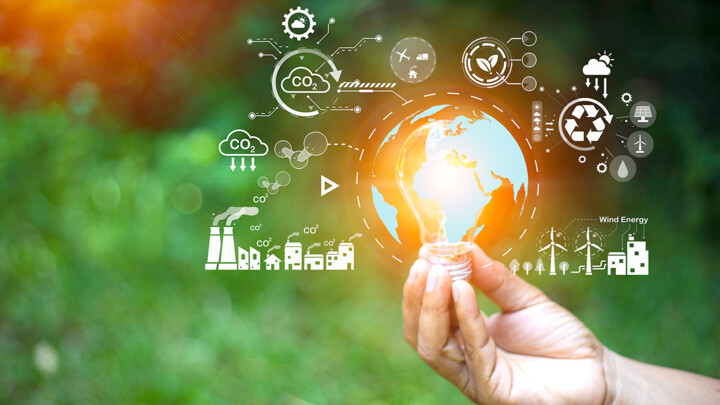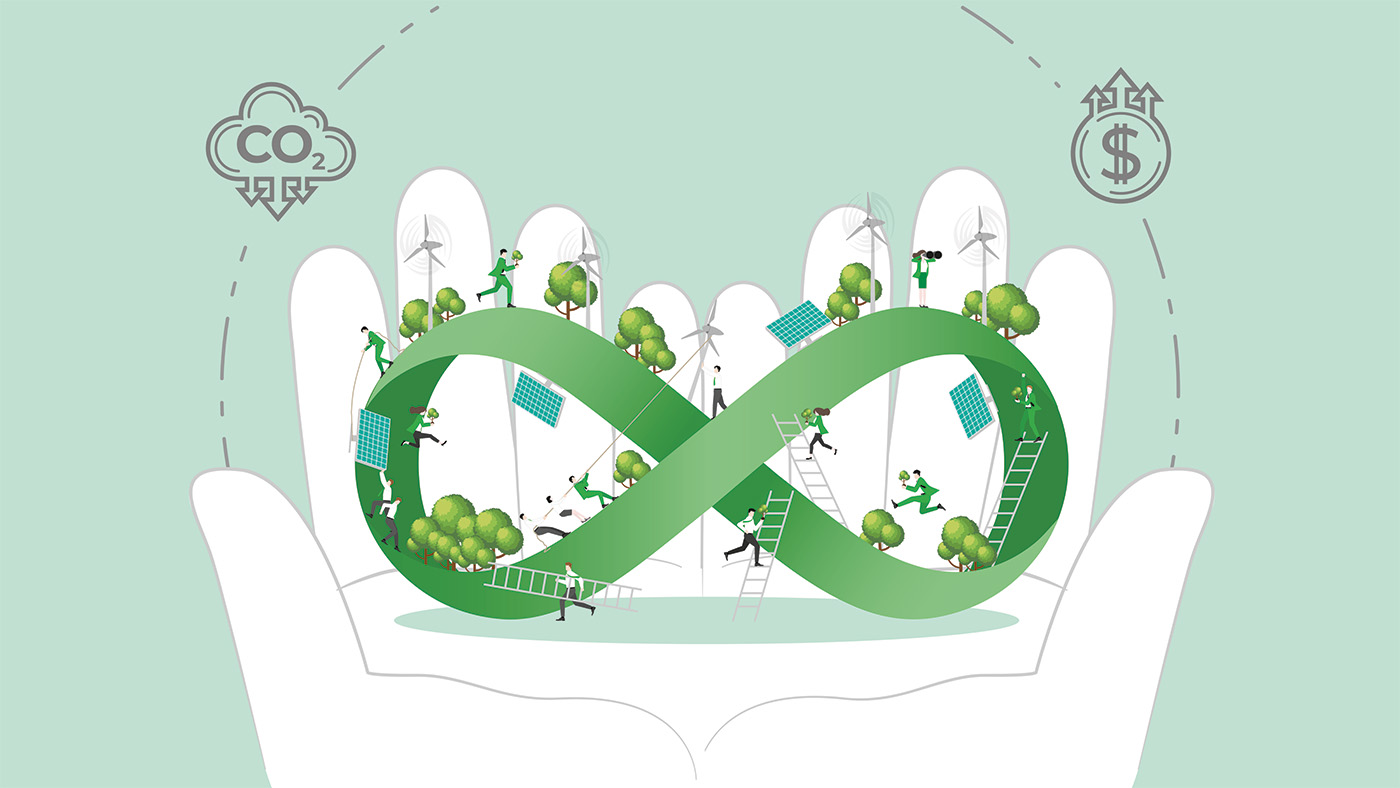Green Data Centers: Benefiting Everyone?
While data centers consume significant energy, Thomas Amberg from Ynvolve underscores how implementing simple green solutions can benefit companies directly while contributing to a far better sustainable future.

©ookawa | istockphoto.com
If you’re reading this, you know it better than most: Data centers are voracious energy consumers. According to IEA, they account now for approximately 1-1.5% of the planet’s electricity use and 1% of energy-related GHG emissions. Despite the 25-fold expansion in global Internet traffic since 2010, emissions have grown modestly, thanks to significant progress in energy efficiency. However, there is still more that we can do: as we are all concerned about the future of our planet, we must continue to make progress in this area.
The good news is that it doesn’t have to be complicated for you. By implementing a few simple solutions, you can benefit your company directly in many ways while contributing to a better future globally. In this article, we will explore how you can make a positive impact and quantify your energy consumption. We will also provide some basic suggestions on how to make your data center greener.
How are green data centers beneficial?
- Environmental impact
As we mentioned, data centers are notoriously energy-intensive. 1-1.5% of the planet’s electricity use might seem small, but it translates to significant carbon emissions, contributing to climate change. Furthermore, this number is bound to increase with the democratization of AI tools and Internet-of-things objects (energy consumption is expected to reach 8% by 2030). By adopting sustainable practices, data centers will substantially reduce their carbon footprint.
- Cost savings
Long-term savings are substantial: Energy-efficient data centers consume less power, leading to lower operational costs, while switching to a circular model of procurement for your IT infrastructure will drastically improve your Return on Investment (ROI). The Uptime Institute’s 2020 Global Data Center Survey found that over 70% of data center operators saw reduced energy costs as a significant benefit of energy efficiency measures. These savings can then be reinvested into other areas of the business, fostering growth and innovation.
- Enhanced corporate image
Since consumers and stakeholders are increasingly environmentally conscious, adopting sustainable practices will certainly enhance a company’s image. Demonstrating a commitment to sustainability can attract eco-minded customers and investors, providing a competitive edge in the market. According to a Nielsen report, 81% of global consumers feel strongly that companies should help improve the environment.
- Regulations
Governments worldwide are starting to catch up with greener energy practices, with companies being forced to report their energy performance in the EU and US, for example. The United Nations zero-emission goal by 2050 will also change a lot of things regulatory-wise: being one step ahead in those situations is always a good idea.
Measuring data center efficiency
This part could very well be an entire article, and we strongly recommend checking out this guide to get a better idea of what factors assess the efficiency of your data center.
You’ll first need to measure and track energy consumption. Two primary metrics are used in the industry to gauge the efficiency of data center energy use: Power Usage Effectiveness (PUE) and Carbon Usage Effectiveness (CUE).
- Power Usage Effectiveness (PUE)
PUE is the ratio of the total amount of energy used by a data center to the energy used by the computing equipment alone. The formula is: PUE = Total Datacenter energyIT equipment energy.
A PUE value of 1.0 indicates perfect efficiency, where all the energy consumed is used for computing with no overhead for cooling, lighting, or other infrastructure. In practice, a PUE of 1.2 or lower is considered very efficient. Regularly monitoring PUE helps data centers identify inefficiencies and areas for improvement.
- Carbon Usage Effectiveness (CUE)
CUE measures the carbon emissions produced per unit of energy consumed by IT equipment. The formula is: CUE = CO₂ emissions caused by IT Equipment Energy.
A lower CUE indicates a more environmentally friendly data center. By tracking CUE, data centers can assess the effectiveness of their renewable energy use and other carbon-reducing measures.
Both PUE and CUE are crucial for understanding and improving the energy efficiency and environmental impact of data centers. Implementing monitoring systems to track these metrics continuously allows data centers to optimize their operations and achieve their sustainability goals.
Schneider developed some handy tools for data centers, helping you to report and disclose greenhouse gas emissions in your operations and calculate exactly your environmental footprint in a granular way: Data Center Greenwashing: Schneider Launches Tools to Help Avoid Fines/ TradeOff Tool Calculators for Data Center PUE | Schneider Electric USA.
Ways to make your data center green
1. Renewable energy sources
Decarbonization of the electricity supplies is one of the most effective ways to make your data center more ecological. Renewable energy sources such as solar, wind, or hydroelectric power have tremendously less effect on the environment than the alternatives. Giants like Google and Microsoft have already made significant strides in this area. Google, for example, has been running its data centers on 100% renewable energy since 2017, significantly reducing its carbon footprint. And it’s often more profitable than we think initially: Increasing the use of renewable energy in the US yields billions of dollars of benefits.
2. Switching to a circular model of IT equipment procurement
The linear model has reached its limits: circular is the future for us. By repurposing or reselling your equipment, you’ll achieve a much better ROI. By buying circular for all of your upgrading needs, you’ll be able to have fit-for-purpose solutions at a very attractive price point, allowing you to always stay on top of your business needs while making substantial savings. This is one of our main areas of expertise, so don’t hesitate to contact us if you have any questions.
3. Energy-efficient hardware
Upgrading to energy-efficient hardware is another crucial step. Modern servers and storage devices consume less power and generate less heat, reducing the need for cooling. The Energy Star program, run by the U.S. Environmental Protection Agency (EPA), certifies hardware that meets high energy efficiency standards, making it easier for companies to choose the right equipment.
4. Efficient cooling solution
Cooling systems are one of the largest energy consumers in data centers. Innovative cooling solutions can dramatically reduce energy consumption. For instance, using outside air for cooling (air-side economization) can cut energy use by up to 60%. Liquid cooling, which uses water or other coolants directly on the heat-generating components, is another efficient alternative, offering better heat transfer and lower energy use.
5. Improved data center design
The physical design of the data center plays a significant role in its energy efficiency. Designing data centers with hot and cold aisles can improve airflow and reduce the need for cooling. Using reflective roofing materials to reduce heat absorption and installing energy-efficient lighting are additional design considerations that can lower energy consumption.
6. Monitoring and optimization
Continuous monitoring and optimization of energy use are essential for maintaining a green data center. Implementing energy management software can provide real-time insights into energy consumption and identify areas for improvement. Regular audits and assessments can ensure that energy efficiency measures are effective and up-to-date.
7. Innovative practices
Finally, some companies are exploring more creative solutions to improve data center sustainability. For instance, Microsoft’s Project Natick involves submerging data centers in the ocean to leverage seawater’s natural cooling properties. Other innovative practices include, amongst others, using AI to optimize energy use and implementing energy storage solutions to manage power more efficiently.
While it may initially seem challenging, transitioning to a green data center offers significant benefits for both the planet and businesses. By reducing energy consumption, cutting costs, and enhancing their corporate image, companies can achieve a sustainable and profitable future. From renewable energy sources to innovative cooling solutions, there are numerous ways to make data centers more environmentally friendly.
Being in the business of better environmental practices for close to two decades now, we are committed to helping businesses achieve their sustainability goals with our circular IT solutions and top-tier customer service, paving the way with our partners for a better future. Please get in touch with any questions, advice, or needs you may have, and let’s all get greener together!
Born and raised in southern Germany, Thomas Amberg is a European at heart. He combines an international mindset with his practical and dynamic approach to life. Studying and living abroad in the Netherlands and Denmark taught him to be adaptable and culturally aware. Now responsible for the development of DACH markets, he is also a passionate handball player.
Please note: The opinions expressed in Industry Insights published by dotmagazine are the author’s or interview partner’s own and do not necessarily reflect the view of the publisher, eco – Association of the Internet Industry.





